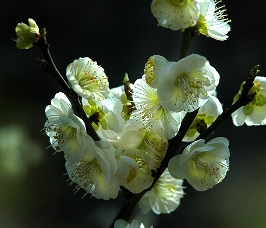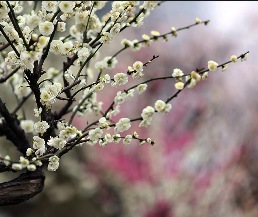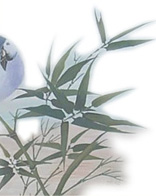|
 Listen to Shirley Singing the Poem in Chinese & English March 30,2012 Listen to Shirley Singing the Poem in Chinese & English March 30,2012
 Listen to Shirley Explaining the Poem & the Culture of Plum Blossom Listen to Shirley Explaining the Poem & the Culture of Plum Blossom
 Follow Shirley to Read the New Words & the Poem in Chinese Follow Shirley to Read the New Words & the Poem in Chinese
 Learn the Meaning of the Poem With Shirley Together Learn the Meaning of the Poem With Shirley Together
 See Shirley Created Picture for the Poem April 1, 2012 See Shirley Created Picture for the Poem April 1, 2012
 See Shirley Created Picture for the Poem August 21, 2011 See Shirley Created Picture for the Poem August 21, 2011
 See Shirley Created Picture for the Poem August, 2010 See Shirley Created Picture for the Poem August, 2010
Zao Mei was written by Tang Dynasty (618-907) poet Zhang Wei (? - 777).
 About the Poet About the Poet
Zhang Wei (? - 777) was from Henei, todayās Xinyang county, Henan Province. He earned his Jin Shi(a successful candidate in the highest imperial examinations) title in 743. He was in the military for more than 10 years before being appointed to several official positions, Shang Shu Lang, Li Bu Shi Lang and then Ci Shi (provincial or prefectural governor) of Tan Zhou.
The characteristics of his poems are: refined wording, depth of meaning and clean poetic style. Zao Mei ? Plum Blossom in the Early Spring is one of his representative works and has been included in almost all Chinese poetry collections.
The Symbolized Meaning of Plum Blossoms
In Chinese culture, Plum Blossom symbolizes:
Gu Qi -- strength of character, moral integrity and backbone;
Gang Yi ? fortitude, indefatigability, perseverance and tenacity;
Xing Fu and Ji Xian -- blessedness,luck and propitiousness.
According to the Confucianism, the plum blossom was the symbol of the gentleman who had the nobleness, personal integrity, fortitude and heroic quality that does not retreat from the adversity. In modern China, Mr. Mao Zedongās lyric -- " Yong Mei -- Chant Plum Blossom" , endowed the plum blossom with some of the spirit of the times, clean breath, steadfastness in the cold season, faithfulness, constant and unbending, independent and self reliant, because he emphasized these qualities in fact the root of the Chinese national verve, since then, the culture of Plum Blossom has met the highest level and it has produced the huge social influence.
Meanwhile, Plum Blossom is also the mascot of happiness and luck.
The ancient Chinese thought that plum blossom has four virtues: āåēäøŗå
ļ¼å¼č±å¦äŗØļ¼ē»åäøŗå©ļ¼ęēäøŗč“ćā Chu sheng wei yuan, kai hua ru heng, jie zi wei li and cheng shu wei zhen ? when it buds means everything is reborn and a new year has started, when it blossoms means things will be prosperous and go smoothly, when it seeds means everywhere there is benefit, when it matures means constancy (another version means satisfaction for the whole of life).
The four words: āå
ļ¼äŗØļ¼å©ļ¼č“ -- Yuan, Heng , Li and Zhen -- beginning, smoothness, benefit and constancy / or satisfaction āwere just the general symbols of Yi Jing -- The Book of Changes.
In Song Dynasty (960 - 1279), Zhu Xi ( 1130 ļ½1200 ) explained the four words as Li, to express the four phases of things from their beginning through growing up to maturity and called it āč“äøčµ·å
-- Zhen Xia Qi Yuan ā, then, it became one of the terms of the Chinese ancient philosophy to express the process by which things go from the beginning to the maturity.
There is another version among the people;āę¢
å¼äŗē¦ -- Mei Kai Wu Fuāmeans Plum Blossom has five petals, it symbolizes: Delight, Happiness, Longevity, Smoothes and Peace.
Besides, in folk art, you can often see a picture of a pied magpie on a plum blossom, that means:
-- Xi bao Zaochun: the pied magpie is reporting that the early spring has come āåę„ę©ę„ā
-- Xi Bao Chunguang: the pied magpie is reporting the spring has comeāåę„ę„å
ā
-- Xi Shang Meishao: uses the same pronunciations between Xi Que ( pied magpie )and Xi Shi (something happy, delight and lucky), on the plum blossom ( its pronunciation is Mei and the eyebrows also read Mei )to express the meaning: āåäøēę¢¢ Happiness appears on the eyebrows.
Enjoy the Poem
This is a Yong Wu Shi ( a form of poetry expressing the feelings and thoughts of the poet through writing about things or objects) that chants about plum blossoms, mainly focusing on the word: ZĒo ? early.
In the early spring, before the snow has melted totally, no other flowers have blossomed yet and there is only the plum blossom to bring vitality and life to the world.
Therefore poeple like to find and to visit the plum blossoms that blossom alone in the cold early spring, Zhang Wei was just one of them.
Let us see the title:ę©ę¢
ZĒo MĆ©i -- The plum blossom in the early spring.
ę© ZĒo means early, ę¢
MĆ©i means plum blossom.
Since ancient China, plum blossom has been chanted by numerous poets, some praise its features, some chant its verve, this poem emphasizes the word āZĒo - early ā.
First line: äøę åÆę¢
ē½ēę”YÄ«shĆ¹ hĆ”nmĆ©i bĆ”iyĆ¹ tiĆ”o -- Flowers cover a plum tree like white jade in the cold . äø yÄ« means one, a ; ę shĆ¹ means tree ; åÆ hĆ”n means cold, ē½ē bĆ”i yĆ¹ means white jade; ē½ bĆ”i means white ;ē yĆ¹ means jade ; ę” tiĆ”o means "branch" ć Whole of the plum blossom tree is covered by its flowers, just like a white jade in the cold season.
This line describes the charming features of the plum blossom, how the white flowers are thick and numerous so that the tree is now white like jade in the cold early spring. One hand, it writes the feature of the plum blossom, the other hand, via pointing out the time that the plum tree flowers. It blossoms quiteę©ZĒo - early, therefore, it has to grow up in the åÆ hĆ”n ? means cold season, hints to us the characteristics of the plum blossom inside -- strong, brave, having the ability to survive in adversity.
Second line: čæ„äø“ęč½åęŗŖꔄ jiĒnglĆn zÅ«nluĆ² bĆ ng xÄ«qiĆ”o line -- It is far away from the village road and near the bridge over the stream.
čæ„ jiĒng means far away ; äø“ lĆn means arrive, be close to ; ęcÅ«n means village ; č·ÆlĆ¹ means road å bĆ ng means near; ęŗŖ xÄ« means stream ; ꔄ qiĆ”o means bridge.
This line describes the environment that the plum blossom grows in. With the comparison of the two wordsčæ„ jiĒng ? far away and å bĆ ng ? near, via writing where it lives , to express its nobleness character.
In reality, the flowers and the grass have no way of choosing their living places, but, this poem melts human thoughts and ideas into the scenery, as if the plum tree intentionally grows far away from the village road and lives in a remote place, near the water and by the stream, to blossom alone. In this way, this line endows the early plum blossom with the noble personality of those excellent people that do not pursue the earthliness and do not play to the crowd.
Based on the first line, this line opens a wider artistic conception for the poem and highlights the nobleness of the plum blossom more. This line is a connecting link between the preceding and the following and is a necessary transition in the poem.
After inheriting the extending writing in the first two lines, last two lines express the poetās lovely surprised feelings.
äøē„čæę°“č±å
å bĆ¹zhÄ« jƬn shuĒ huÄ xiÄn fÄ -- I didnāt know the flowers blossom earlier by the water.
äø bĆ¹ means no, do not ; ē„ zhÄ« means know, realize, čæ jƬn means near ; ę°“ shuĒ means water, river, sea, stream ; č± huÄ means flower, blossom ; å
xiÄn means first, earlier, at the first, here means the earliest ; å fÄ means set off, here means "open", "blossom" .
With an exclamation style, expresses the lovely surprised feelings of the poet. This line tells us why this plum blossom tree opened its flowers earliest.
ēęÆē»å¬éŖęŖę¶ yĆ shƬ jÄ«ng dÅng xuÄ wĆØi xiÄo - I thought (had Doubted ) it was the snow in the winter that had not melted yet.
ē yĆmeans guess, doubt, suspect; ęÆ shƬmeans to be, is, are ;ē» jÄ«ng means pass, experience ; å¬ dÅng means winter; éŖxuÄmeans snow; ęŖ wĆØi means not;ę¶ xiÄo means melt, disappear.
This line recalls the first line, -- in fact the poet is ā deceivedā by an illusion so that he mistook the white plum blossoms for the white snow that has not melted in the early spring.
With the word äøē„ bĆ¹zhÄ«- donāt know and ē yĆ - doubt together, describe how the poet felt blurred and in a trance when he looked over the plum blossom tree from the far away, and then when he went nearer and looked at it carefully, then he just found it was a tree of plum blossoms that near the water, had opened its flowers. Now, the doubt has been excluded and the āearlyā in the title has been pointed out.
The āflowers as if snowā in the last line echoes with the āplum blossom as white jadeā in the first line, and says how the feature of the plum blossom is that it is white, clean and unyielding, to carry out the connotation of the poem indirectly, the theme has been deeper more.
This poem does not use any remark or praised word directly, but, it has written out the main meaning of the poem and the love of the poet to the plum blossom very clear, Why?
Apart from the novel conception, with the simple, easy, refined and frank language, this poem captures something special in the reality of life to express:
The Colour of the early plum blossom: whiteness as jade ? clean and noble;
The Place it grows up: remote ? does not pursue earthliness;
The Season of it blossoms: early spring ? can live in a hard situation;
The Feature: beautiful.
Therefore, in so many poems that chant about the plum blossom, Zhang Weiās Zao Mei stands there peacefully and gracefully, just like a girl in a white dress and does not makeup. When we look at it from far away, it is hiding in the numerous beauties, but when we see it carefully, then we can feel how it is light, elegant, clean and wonderful, with a leisurely and artistic conception...
Plum blossom and snow is ususally indissoluble bounded and people have had similar illusion and thought about the plum blossom as snow. Wang Anshi (1021ā1086) in Song Dynasty said : é„ē„äøęÆéŖļ¼äøŗęęé¦ę„ ? Yao zhi bu shi xue, wei you an xiang lai ? know it is not snow, because the fragrance of the flowers I have smelled from far away. Both of the poems are really different in approach but equally satisfactory in result.
From feeling the plum blossom as like white jade, thinking it was the winter snow, until knowing it is just the clean white plum blossom, the poet describes the process that he uses to see, to think and to explore. At the same time, following the writing that extends through the transition and to the reference between the beginning and the end, readers can also appreciate the charming plum blossom and the never-failing meanings in the poem.
I saw plum blossoms first time in Shanghai in the spring in 1979, then, since 1983, almost every year, I have been in the plum blossoms to enjoy the beautiful flower and the feel why Chinese love it.
With my own imagination, I had created a piece of music for the peom and sang it in 2006; then in August 2010 and Auguest, 2011, I created two paintings to match this poet, instead of creating the poet in my painting, I would like to express the surprised feelings by the birds --golden pheasant instead of a person itself... :-)
This week, in CNAA, March, 2012, I redid all of the things by the good help of my tutors on English, painting and music.
I do hope that out effort be some help with you to learn Chinese langauge and culture.
The Main Meaning of the Poem :
Flowers cover a plum blossom tree like a white jade in the cold,
Far away from the village road near the bridge over the stream.
I didn't know the flowers blossom early by the water,
I doubted that was the winter snow had not melted.
Chinese Characters and Pronunciations
You can clink any Chinese Character to open the New Character Board and to see its Chinese pinyin, meaning, pronunciation and follow me to read it, also, you can hit the links over to enter the Painting Column,or you can directly enter the art notes on the painting that I created for this poem to see my painting and art notes for the poem
ę©ę¢
- ZĒo MĆ©i
å¼ ęø ļ¼åļ¼- ZhÄng WĆØi (TĆ”ng)
äøę åÆ ę¢
ē½ ē ę”- YÄ«shĆ¹ hĆ”nmĆ©i bĆ”iyĆ¹ tiĆ”o,ļ¼
čæ„äø“ęč·ÆåęŗŖꔄ - jiĒnglĆn zÅ«nlĆ¹ bĆ ng xÄ«qiĆ”oć
äøē„čæę°“č±å
å - BĆ¹zhÄ« jƬn shuĒ huÄ xiÄn fÄļ¼
ēęÆē»å¬éŖęŖę¶ - yĆ shƬ jÄ«ng dÅng xuÄ wĆØi xiÄoć
 If you have any questions, comments and suggestions, please write to shirley@ebridge.cn or shirleyz004@yahoo.com. You are welcome to publish your opinions in Message Board as well. If you have any questions, comments and suggestions, please write to shirley@ebridge.cn or shirleyz004@yahoo.com. You are welcome to publish your opinions in Message Board as well.
Shirley Zhang
April 2, 2012/ August 21, 2011/ August 1, 2010/Jun 25,2006
|

